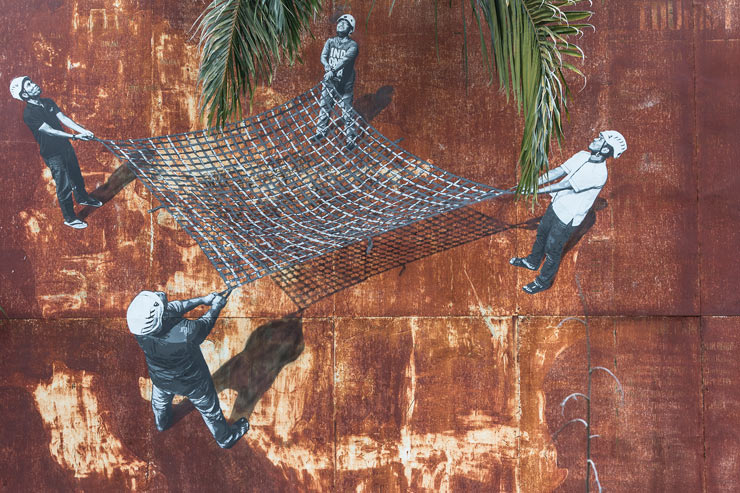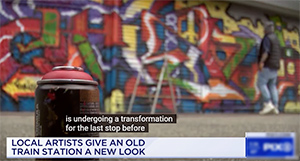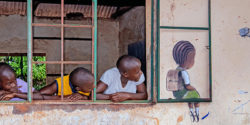Activism in the practice of Street Art and murals continues to inject itself into different situations, adding to its own definition, and perhaps challenging ours.
Part of a larger campaign called “Splash and Burn,” today we have Norwegian stencil artist Strøk, aka Anders Gjnnestad, with a brand new piece he did in Bukit Lawang, North Sumatra, Indonesia.
The image of a huge net is not remarkable except for Strøk’s characteristic play on perspective and planes, and the fact that the subject is Orangutans, or rather, an increasing lack of them.
Strøk for Splash & Burn Project. Sumatra 2016. (photo © Strøk)
EcoTourism has become such a huge industry in the last decade and a half thanks to Westerners longing to do something meaningful and engaging on their vacations aside from going to an amusement park or lying by the beach. Unfortunately, irresponsible development, untrained “guides” and uncaring tourists have trampled over the natural areas, changed the natural behavior of wild animals and endangered their future – with Orangutans in Bukit Lawang as a prime example. The lure of tour money and the behaviors of visitors ignoring even basic rules like “don’t feed the wild orangutans” has created a lot of aggressive animals who are now dependent on you for food and the uncontrolled hordes of visitors have damaged the living environment.
“I just found that what I wanted to create was a mural about Orangutans and one of the main problems they are facing – destruction of habitat,” says Strøk of his new piece.
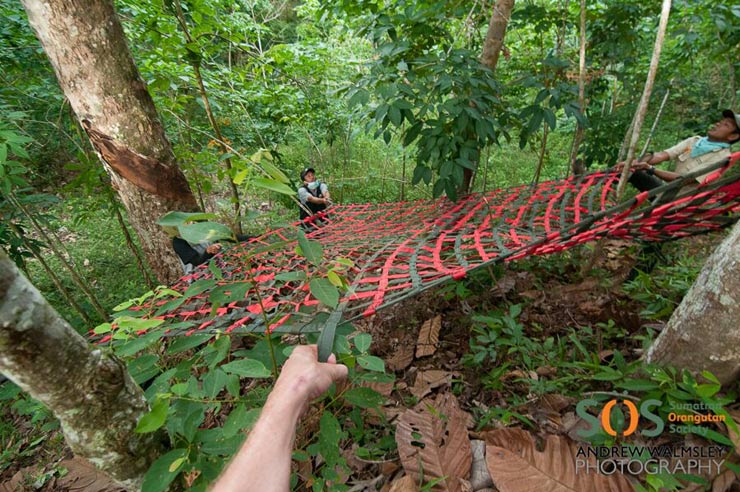
Reference photo. Rescuers working for Sumatra Orangutan Society or SOS for its initials in English prepare a net to catch an Orangutan about to fall down from a tall tree. (photo © Andrew Walmsley)
With a desire to educate himself about what orangutans are like and how some of them need rescuing and relocating, the artist went to the Orangutan Information Centre headquarters in Medan and met with the people working there. “While being given a presentation of their work, I got the idea of what I wanted to paint. They showed us photos of how they work with the SOS (Sumatran Orangutan Society) to rescue and relocate orangutans in trouble,” he explains. “Orangutans travel great distances almost daily, in search for food. If the jungle is cut down around them and they get stuck in a small pocket of trees, that’s bad news for them.”
“Basically, OIC/SOS have a hotline that people can call if they see a distressed orangutan. Then the OIC/SOS gets together their team that is on standby, go to the location and they shoot the Orangutan with a sedation dart. When it sleeps and falls down from its tree, they are standing below it, breaking the fall with a net – much like the old school fireman rescue method. Then the orangutan gets checked by a vet, and depending on its condition it is either relocated into the wild, or taken to a rehabilitation facility.
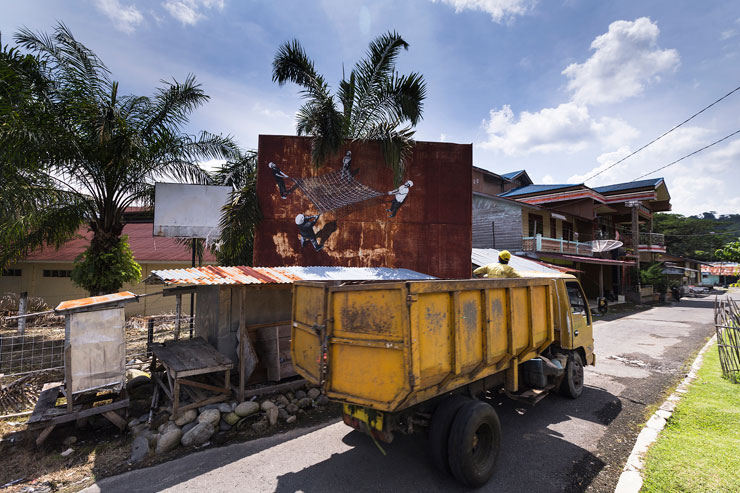
Strøk for Splash & Burn Project. Sumatra 2016. (photo © Strøk)
The new stenciled and sprayed wall piece was created to evoke the image of the animal falling to safety and as a larger metaphor about our collective responsibility to care for nature and its other inhabitants. Strøk says he really liked the location he worked with, and after taking photos while standing on a roof of local guys holding the net, he created the stencils and started painting.
“I was free to do whatever I wanted, on whatever wall or surface I preferred and that we could get permission to paint. On top of my list was a rusty old tourist agency billboard with a barely visible map of Sumatra that was along the main road as you enter the village. I integrated the oil palm tree that was already directly behind and leaning over the billboard into the composition of my painting,” he says
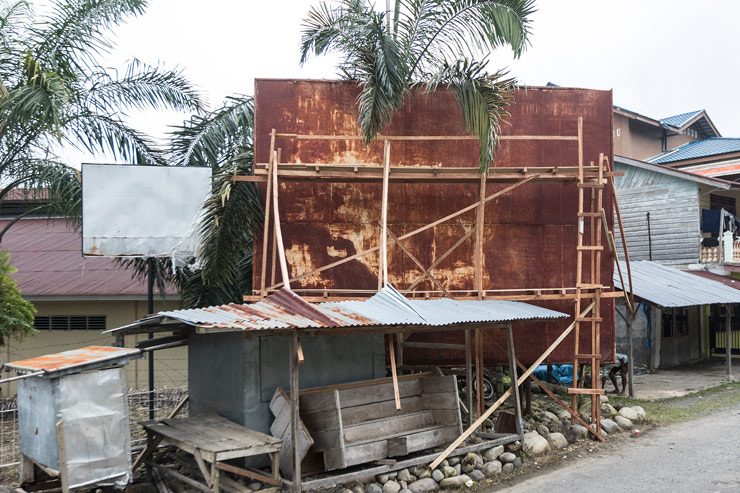
Strøk for Splash & Burn Project. Sumatra 2016. (photo © Strøk)
This might be a bit of a sidenote, but I wanted to include this photo of the construction I was standing on to paint. “I´ve always had massive respect to people who can put together something good and solid, in an effective way. This construction was put up for me by two local men in about an hour, and proved to fit me and the work I needed to do, like a glove. I am glad they got a look at me before they started, though, as I am about 1,5 times the height and at least double the weight of an average Indonesian. They tailored it so I could stand up straight on the middle level and climb up and down with confidence.”- Strøk
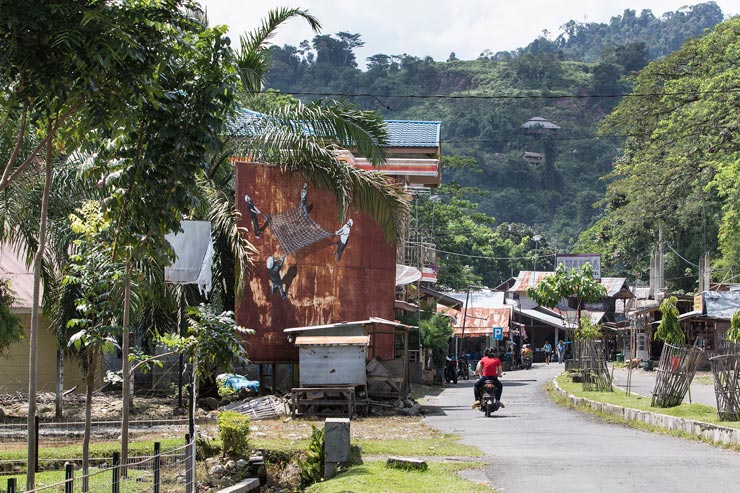
Strøk for Splash & Burn Project. Sumatra 2016. (photo © Strøk)
The palm oil tree that reaches over the front of the new piece is significant because this installation is part of a larger campaign about the palm oil industry begun by Lithuanian artist Ernest Zacharevic, who raised money for Strøk and six other artists this January by selling a special lithograph print called “Splash and Burn”
Other artists like Mark Jenkins, Isaac Cordal, Pixel Pancho, Gabriel Pitcher, Bibichun, and Axel Void all participated in the first series of installations, and Zacharevic intends to develop the project further to raise awareness about the negative impact that our often unregulated industrial world is having on the natural one, and the people, animals and ecosystems that depend on it. For more information on “Splash and Burn” check out the new article just published in The Guardian.
“For this project I knew I wanted my work to connected on more levels, to tell a more specific story in a way,” StrØk tells us. “I wanted to create a work about Orangutans without painting one. It was a challenge, but a very welcome one.”
To read about an unregulated industry of ecotourism that is not eco-friendly and is very possibly ruining the habitat for orangutans, go here.
Our sincere thanks to Charlotte Pyatt for her help in the project and with this article.
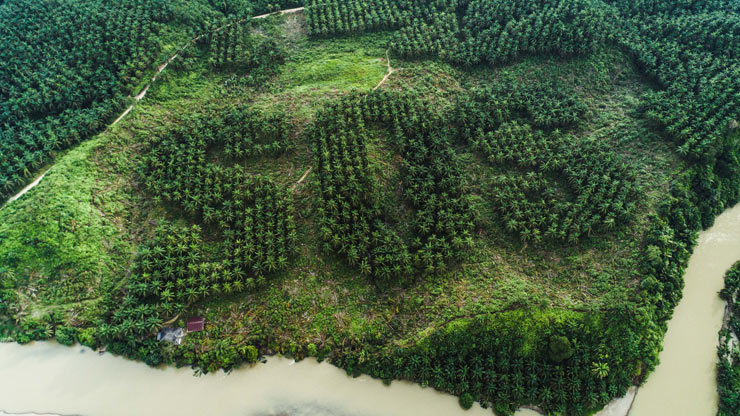

 BROOKLYN STREET ART LOVES YOU MORE EVERY DAY
BROOKLYN STREET ART LOVES YOU MORE EVERY DAY
